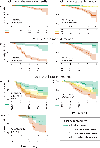Optimal combinations of CSF biomarkers for predicting cognitive decline and clinical conversion in cognitively unimpaired participants and mild cognitive impairment patients: A multi-cohort study
- PMID: 36648169
- PMCID: PMC10350470
- DOI: 10.1002/alz.12907
Optimal combinations of CSF biomarkers for predicting cognitive decline and clinical conversion in cognitively unimpaired participants and mild cognitive impairment patients: A multi-cohort study
Abstract
Introduction: Our objective was determining the optimal combinations of cerebrospinal fluid (CSF) biomarkers for predicting disease progression in Alzheimer's disease (AD) and other neurodegenerative diseases.
Methods: We included 1,983 participants from three different cohorts with longitudinal cognitive and clinical data, and baseline CSF levels of Aβ42, Aβ40, phosphorylated tau at threonine-181 (p-tau), neurofilament light (NfL), neurogranin, α-synuclein, soluble triggering receptor expressed on myeloid cells 2 (sTREM2), glial fibrillary acidic protein (GFAP), YKL-40, S100b, and interleukin 6 (IL-6) (Elecsys NeuroToolKit).
Results: Change of modified Preclinical Alzheimer's Cognitive Composite (mPACC) in cognitively unimpaired (CU) was best predicted by p-tau/Aβ42 alone (R2 ≥ 0.31) or together with NfL (R2 = 0.25), while p-tau/Aβ42 (R2 ≥ 0.19) was sufficient to accurately predict change of the Mini-Mental State Examination (MMSE) in mild cognitive impairment (MCI) patients. P-tau/Aβ42 (AUC ≥ 0.87) and p-tau/Aβ42 together with NfL (AUC ≥ 0.75) were the best predictors of conversion to AD and all-cause dementia, respectively.
Discussion: P-tau/Aβ42 is sufficient for predicting progression in AD, with very high accuracy. Adding NfL improves the prediction of all-cause dementia conversion and cognitive decline.
Keywords: BioFINDER; WADRC; WRAP; amyloid-β; cognitive decline; conversion to dementia; glial activation; inflammation; neurodegeneration; tau ratio.
© 2023 The Authors. Alzheimer's & Dementia published by Wiley Periodicals LLC on behalf of Alzheimer's Association.
Conflict of interest statement
OH has acquired research support (for the institution) from ADx, AVID Radiopharmaceuticals, Biogen, Eli Lilly, Eisai, Fujirebio, GE Healthcare, Pfizer, and Roche. In the past 2 years, he has received consultancy/speaker fees from Amylyx, Alzpath, BioArctic, Biogen, Cerveau, Fujirebio, Genentech, Novartis, Roche, and Siemens. GK and NW are employees of Roche Diagnostics. SP has served on scientific advisory boards and/or given lectures in symposia sponsored by Biogen, Eli Lilly, Geras Solutions, and Roche. HZ has served at scientific advisory boards and/or as a consultant for Abbvie, Alector, Annexon, Artery Therapeutics, AZTherapies, CogRx, Denali, Eisai, Nervgen, Novo Nordisk, Pinteon Therapeutics, Red Abbey Labs, Passage Bio, Roche, Samumed, Siemens Healthineers, Triplet Therapeutics, and Wave, has given lectures in symposia sponsored by Cellectricon, Fujirebio, Alzecure, Biogen, and Roche, and is a co-founder of Brain Biomarker Solutions in Gothenburg AB (BBS), which is a part of the GU Ventures Incubator Program (outside submitted work). KB has served as a consultant, at advisory boards, or at data monitoring committees for Abcam, Axon, Biogen, JOMDD/Shimadzu. Julius Clinical, Lilly, MagQu, Novartis, Prothena, Roche Diagnostics, and Siemens Healthineers, and is a co-founder of Brain Biomarker Solutions in Gothenburg AB (BBS), which is a part of the GU Ventures Incubator Program. SCJ previously served on an advisory board for Roche Diagnostics, and receives research funding from NIH and from Cerveau Technologies. COBAS, COBAS E and ELECSYS are trademarks of Roche. The Elecsys β-Amyloid (1-42) CSF assay, the Elecsys Phospo-Tau (181P) CSF assay and the Elecsys Total-Tau CSF assay are not approved for clinical use in the US. The NeuroToolKit robust prototype assays are for investigational purposes and are not approved for clinical use. GSB, VL, KAC, NCC, EMJ, ES, SJ, NMC and RO have nothing to disclose.
Figures



References
Publication types
MeSH terms
Substances
Grants and funding
LinkOut - more resources
Full Text Sources
Medical
Miscellaneous

